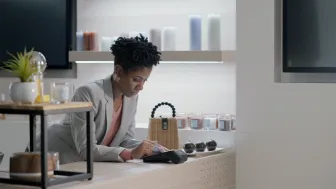The retail industry is at a turning point. Its workforce has changed and its customers have evolved, creating a vastly different dynamic since 2019 and skewing retail trends toward self-service and automation.
Job openings in retail continue to number about 800,000, and by many accounts, the workforce is now as good as it gets. The global population is aging and, according to UN data, birth rates are flat and projected to decline. These trends add up to fewer available workers for the retail industry (and other industries). While some view immigration or incentivizing people to raise families as an answer, a more immediate and predictable solution is implementing self-service and automation technology.
Furthermore, at the same time that the dramatic decline in the workforce began, consumer habits changed. The COVID-19 pandemic forced consumers to find new ways to interact with retailers, increasing the adoption of online shopping, self-service, and contactless payments, and those trends have staying power. To provide the experiences that will earn shoppers’ loyalty, they must deploy technology to support them.
Retail Technology Taking Center Stage
At the Retail Solutions Providers Association (RSPA) RetailNOW this year, conversations about the future of the industry revolved around these technologies and how they can help retailers operate more effectively and competitively:
- Artificial intelligence (AI) and machine learning (ML)
The National Retail Federation (NRF) sees potential for AI, including targeting marketing, analyzing data for insights that help streamline operations, enhancing forecasting, and optimizing pricing. Also, instead of a human answering the phone when a customer needs assistance, an AI voice chatbot will be the first point of contact. Generative AI allows systems to answer basic questions and only pass complex issues to employees for intervention, saving time and decreasing the need for customer service agents.
- Virtual reality (VR)
VR gives retailers the ability to create immersive experiences, such as smart fitting rooms and virtual assisted shopping that consumers love yet require minimal intervention from employees.
- The Internet of Things (IoT)
IoT solutions can track orders from start to finish, reporting location, route, environmental conditions, and handling to ensure quality fulfillment, products, and service. It can also be a cost- and energy-saving solution, controlling lighting, heating, and water usage automatically.
- Robots
Robots can take stock and replenish merchandise on the sales floor, and “humanized robots” can assist customers as they shop. Robots and cobots also enhance fulfillment centers and warehouses, helping humans by handling routine tasks and moving products, enhancing productivity.
- 5G
5G mobile internet connectivity delivers greater speed and reliability and supports more devices in a given area. 5G allows retailers to implement advanced technologies by enabling adequate bandwidth. It also supports more efficient supply chains with connectivity for robotics and real-time communications and analytics.
Transitioning to these technologies requires a change in mindset for retailers and their solutions providers. It’s important to recognize that automating processes and implementing self-service solutions aren’t taking jobs away from people. They’re replacing jobs that may never be filled. In addition, they’re meeting modern consumers’ demands and giving retailers a path to competitiveness.
Jay McBain, chief analyst at Canalys and RetailNOW keynote speaker, pointed out that in 18 months, the majority of retail buyers will be millennials ready to embrace more digital processes, and in five years, 79% of customer experiences will be unrecognizable by today’s standards.
More Technology, More Security
As retailers digitally transform their operations with integrated systems connected to communications networks, they will also increase their risk of cyberattacks. This compounds the ongoing issue of theft and fraud, which costs the industry $100 billion per year.
Security will become a top priority for retailers to control losses and shrinkage. Fortunately, advanced technologies, like AI and machine learning, can monitor activity, both in the store and online, and alert retailers of potentially malicious activity in real time so they can prevent loss.
Payments in Retail’s Brave New World
As retail reimagines its operations, it must also consider how to manage transactions. Money won’t literally change hands. Instead, consumers will make payments at self-service kiosks or on mobile devices. Payments can’t be an afterthought. Transaction processes must be considered as retailers are implementing new solutions, so they can be integrated into automated workflows and provide the best customer experiences.
Payments must also be more than accepting credit or debit cards. Retailers must know their customers and the types of payments they prefer, from mobile wallets to buy now, pay later (BNPL), and give their customers those choices when they pay.
Retail trends include frictionless payments, moving payments to the background of experiences. This can range from a quick tap-and-go contactless transaction to consumers choosing the products they want simply leaving the store, similar to Amazon Go payment processes. These types of experiences require the support of a range of technologies for accurate, secure transactions, minimal shrinkage, and satisfied customers. Discover more on Ingenico's retail payment solutions.
Retailers Now Know the Secret of Success
Michael LeBlanc, host of the Voice of Retail podcast and RetailNOW keynote speaker, pointed out that retailers were overwhelmed with the massive changes during the COVID-19 era, some even switching from normal brick-and-mortar operations to curbside within days. “Agility and resilience were the secrets to getting through it,” he said. Although another circumstance like COVID is hopefully not imminent, there are other forces that can disrupt operations. Retailers understand that business continuity is a priority.
Some retailers have fully embraced technology for continued operations that are less dependent on labor and that deliver customer-centric digital experiences. Others are taking a more cautious approach. But they all know the future is here. It’s time for retailers to adapt and embrace the industry’s new reality and survive disruption.
Ready to elevate your payment experience? Our experts are here to help you find the perfect payment solution for your business. Contact us today.











